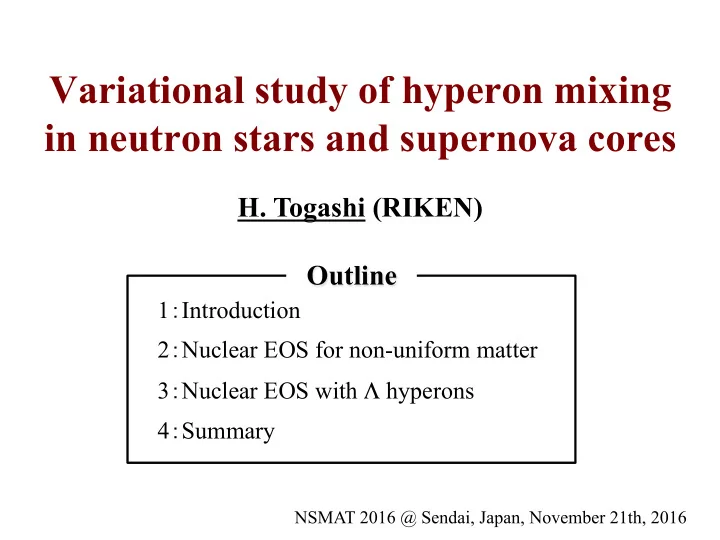

Variational study of hyperon mixing in neutron stars and supernova cores H. Togashi (RIKEN) Outline 1 : Introduction 2 : Nuclear EOS for non-uniform matter 3 : Nuclear EOS with Λ hyperons 4 : Summary NSMAT 2016 @ Sendai, Japan, November 21th, 2016
1: Introduction Nuclear equation of state (EOS) for core-collapse supernova (SN) simulations 1. Lattimer-Swesty EOS : The Skyrme-type interaction (NPA 535 (1991) 331) 2. Shen EOS : The Relativistic Mean Field Theory (NPA 637 (1998) 435) SN-EOS list by M. Hempel Hyperon EOS There are no supernova EOSs based on the microscopic many-body theory.
Our Plan to Construct the SN-EOS Nuclear EOS for Uniform Matter • Nuclear Potential : Argonne v18 (AV18) + Urbana IX (UIX) • Wave Function : Jastrow wave function • Method : Cluster variational method (NPA902 (2013) 53) Low-density region High-density region Nuclear EOS for Non-uniform Matter with the Thomas-Fermi calculation M. Takano (Waseda Univ.) , K. Nakazato (Kyushu Univ.), Y. Takehara, S. Yamamuro, H. Suzuki (Tokyo Univ. of Science) Nuclear EOS with Λ Hyperons using an extension of the cluster variational method M. Takano (Waseda Univ.) , E. Hiyama (RIKEN)
2: Nuclear EOS for Non-uniform Matter We use the Thomas-Fermi method by Shen et al. (PTP 100 (1998) 1013, APJS 197(2011) 20) Free energy of a Wigner-Seitz cell Bulk energy Gradient energy Coulomb energy f : Free energy density of uniform nuclear matter Particle number density distributions Protons and neutrons ( i = p, n) Alpha-particles
Phase Diagram of Hot Nuclear Matter H. T. et al., submitted to Nucl. Phys. A
Heavy Nuclei in Supernova Matter → The density derivative coefficient of the symmetry energy L (Our EOS: L = 35 MeV Shen EOS: L = 111 MeV) Details are discussed by Oyamatsu & Iida in PRC 75 (2007) 015801 More by K. Nakazato on Wed. H. T. et al., submitted to Nucl. Phys. A
Free Energy & Pressure H. T. et al., submitted to Nucl. Phys. A
3: Nuclear EOS with Λ Hyperons Hamiltonian of hyperon matter H N : Nuclear Hamiltonian (AV18+UIX) Hyperon interactions are determined so as to reproduce the experimental data on single-and double- Λ hypernuclei. (E. Hiyama et al., PRC 74 (2006) 054312, PRC 66 (2002) 024007) The expectation value of H is calculated with the Jastrow wave function in the two-body cluster approximation Φ F : Fermi-gas wave function
Energy of Hyperon Matter Baryon number density: n B = n p + n n + n Λ n i : Particle number density x i = n i / n B : Particle fraction ( i = p, n, Λ )
Free Energy of Hyperon Matter We follow the prescription proposed by Schmidt and Pandharipande. (K. E. Schmidt et al., Phys. Lett. 87B(1979) 11) (A. Mukherjee et al., PRC 75(2007) 035802) Free energy F is expressed by the average occupation probabilities. ε i ( k ): Single particle energy � ( i = p, n, Λ ) m i *: Effective mass of baryons � Free energy is minimized with respect to m i * Free energy of hyperonic nuclear matter
Application to Neutron Stars Mass-radius relations of neutron stars J0348+0432: Science 340 (2013) 1233232 J1614-2230: Nature 467 (2010) 1081 Shaded region is the observationally suggested region by Steiner et al. (Astrophys. J. 722 (2010) 33)
Application to Supernova Cores We construct the EOS of supernova matter with the following conditions. 1. Isothermal matter ( T = 10, 20, and 30 MeV) � 2. β -stable matter with trapped neutrinos 3. Fixed electron fraction : Y e = 0, 0.3, 0.5 Fractions of Λ hyperons X Λ in supernova matter
Hyperon Three-Body Force We consider a simplified hyperon three-body repulsive force (TBF) for Λ NN , ΛΛ ΛΛ N , and ΛΛΛ ΛΛΛ systems. (Y. Yamamoto et al., PRC 90 (2014) 045805) (H. T. et al., PRC 93 (2016) 035808) P r e l i m i n a r y Variational Shen EOS Mass-radius relations of neutron stars X Λ in supernova matter
Summary 1. New nuclear EOS for SN simulations is constructed with realistic nuclear forces (AV18 + UIX). • EOS of uniform nuclear matter is constructed with the cluster variational method . • EOS of non-uniform nuclear matter is constructed with the Thomas-Fermi calculation . Our complete SN-EOS table will be available soon! 2. Our SN-EOS table is extended to consider Λ hyperon mixing at zero and finite temperatures. • The effect of Λ hyperons on supernova matter becomes larger at higher temperatures and lower proton fractions.
Recommend
More recommend